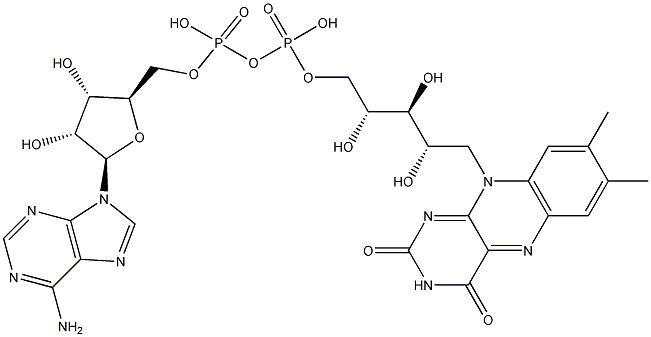adenineflavin


Structural formula
| Business number | 03WW |
|---|---|
| Molecular formula | C27H33N9O15P2 |
| Molecular weight | 785.55 |
| label |
Adenine flavin dinucleotide, dinucleotide riboflavin adenosine, dinucleotide flavin adenine, Riboflavin adenosine dinucleotide, Active form of vitamin B2; riboflavin-5′-adenosine diphosphate, Adenine-riboflavindinucleotide, FAD, Flavinadenindinucleotide, Riboflavin-5′-adenosine-diphosphate, Skin and mucous membrane disorders |
Numbering system
CAS number:146-14-5
MDL number:None
EINECS number:282-733-8
RTECS number:AU7470000
BRN number:None
PubChem ID:None
Physical property data
1. Physical property data:
1. Appearance: orange-yellow powder
2. Solubility: easily soluble in water, insoluble in ethanol, aqueous solution shows yellow-green fluorescence, when exposed to Alkali breaks down into riboflavin.
Toxicological data
2. Toxicological data:
1. Acute toxicity:
Mouse oral LC50: >7 gm/kg;
Mouse intravenous LC50: 589 mg/kg.
Ecological data
3. Ecological data:
Usually it is not harmful to water. Do not discharge materials into the surrounding environment without government permission.
Molecular structure data
5. Molecular property data:
1. Molar refractive index: 168.11
2. Molar volume (cm3/mol): 376.2
3. Isotonic specific volume (90.2K): 1230.5
4. Surface tension (dyne/cm): 114.4
5. Polarizability (10-24cm3): 66.64
Compute chemical data
IV. Calculated chemical data:
1. Hydrophobic parameter calculation reference value (XlogP): -5
2. Number of hydrogen bond donors: 9
3. Number of hydrogen bond acceptors: 21
4. Number of rotatable chemical bonds: 13
5. Topological molecular polar surface area (TPSA): 356
6. Number of heavy atoms: 53
7. Surface charge: 0
8. Complexity: 1560
9. Number of isotope atoms: 0
10. Determine the number of atomic stereocenters: 7
11. Uncertain number of atomic stereocenters: 0
12. Determine the number of chemical bond stereocenters: 0
13. The number of uncertain stereocenters of chemical bonds: 0
14. The number of covalent bond units: 1
Properties and stability
Stable under normal temperature and pressure.
Storage method
Store at -20 ºC.
Synthesis method
Purpose
1. Suitable for skin and mucous membrane diseases, neurological tinnitus, cerebral arteriosclerosis, intractable headaches, cirrhosis, jaundice and other liver diseases, eye diseases, and retinal diseases. Intravenous injection too fast may cause temporary chest discomfort.